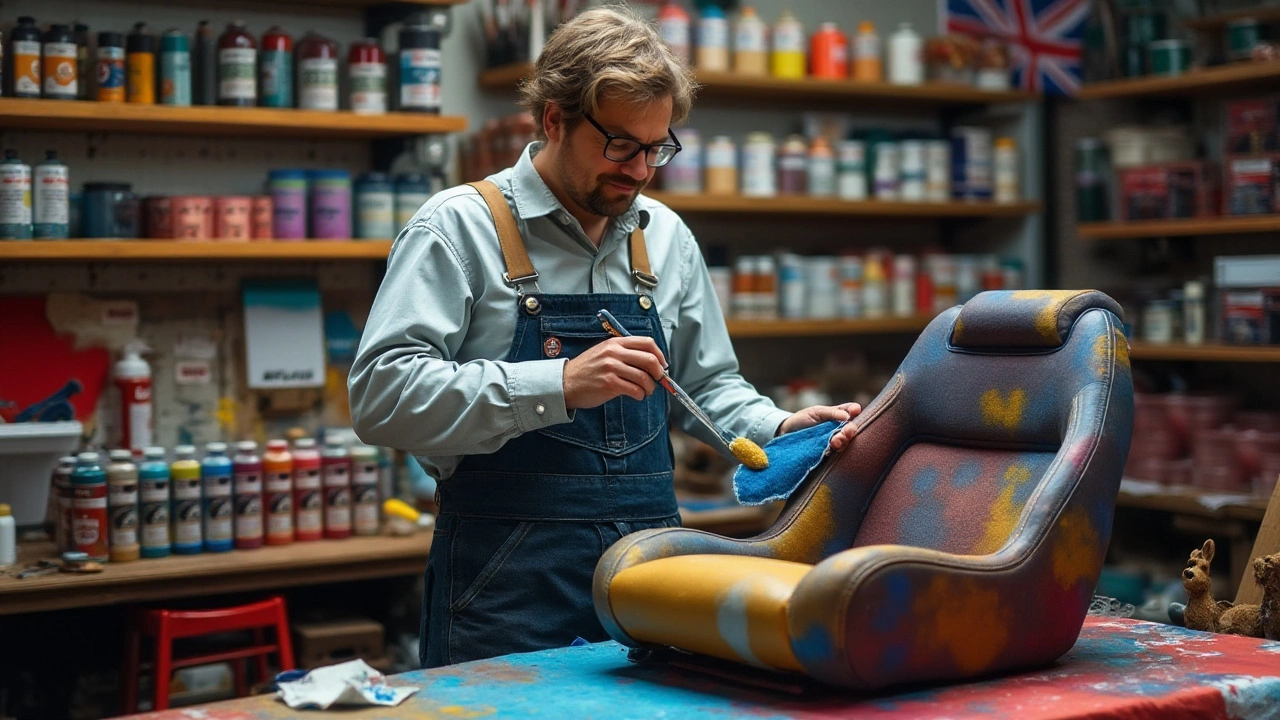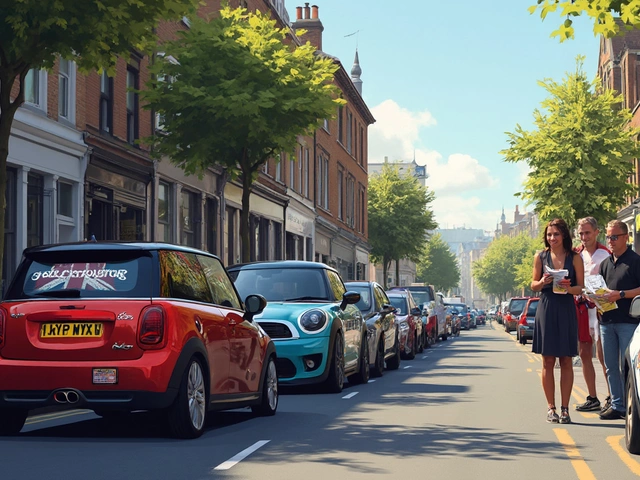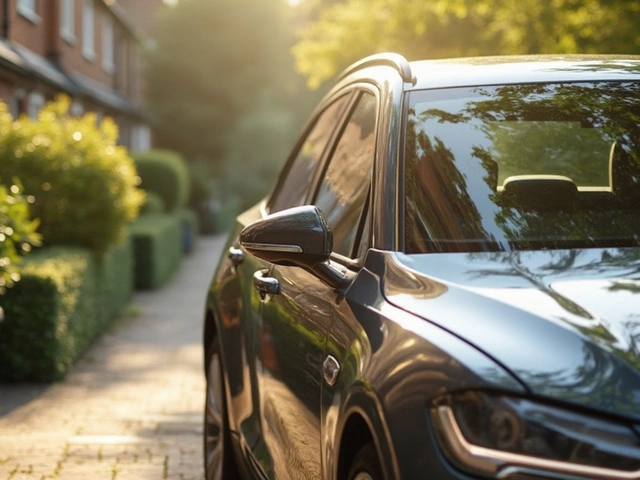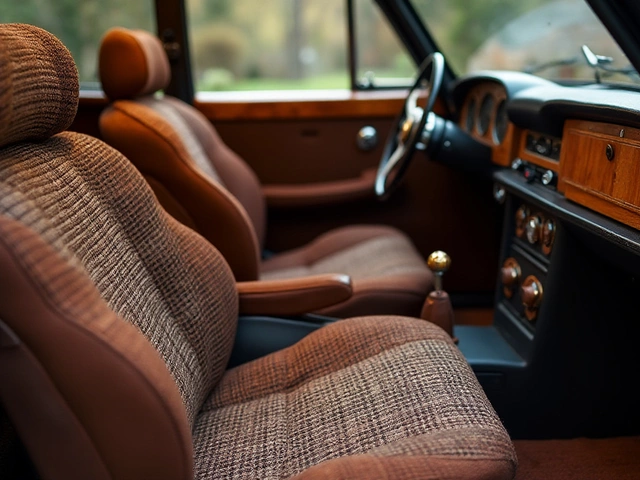Changing the interior vibe of your car doesn't always require a hefty investment. For those who crave change and are driven by creativity, painting car interior fabric is an exciting option. It offers car owners an affordable way to express their style and refresh the look of their vehicle.
This approach involves more than slapping on a coat of paint—it's about understanding the fabric, selecting the right materials, and executing with care. Whether you're looking to touch up worn-out areas or you're in the mood for a complete makeover, crafting a plan with the right tools is key. Let's walk through the essentials to help you confidently embark on this DIY journey.
- Why Paint Car Interior Fabric
- Choosing the Right Paint and Tools
- Preparing the Fabric
- Step-by-Step Painting Process
- Care and Maintenance of Painted Fabric
- Creative Ideas for Custom Designs
Why Paint Car Interior Fabric
Revamping the car interior fabric with paint isn't just about aesthetics; it's about personalization and practicality. Many vehicle owners find that as their cars age, the interiors lose their charm. Fabrics can fade, stain, and even begin to show signs of wear and tear. Instead of opting for costly replacements, a coat of paint provides a budget-friendly alternative to breathe new life into tired interiors. With the right technique, you can achieve a professional look while adding a personal touch that reflects your unique style.
Another compelling reason to paint the interior is the variety it offers. Unlike traditional fabric replacements, which limit you to a preset selection of colors and textures, painting allows you almost unlimited design freedom. Whether you're inspired by the sleek elegance of a monochrome palette or the bold statements that come with vibrant hues, painting empowers you to make choices that speak to who you are. Many enthusiasts find joy in using stencils and blending techniques to create custom designs that no factory-produced upholstery can rival.
"Customizing a car’s interior is like adding a unique signature to your vehicle," says auto design expert Jared Thompson.
Painting car interiors is not only an artistic endeavor but also a practical one. For those dealing with difficult-to-remove stains or discolored areas, painting offers a way to cover these blemishes smoothly. Technologies in paint have advanced significantly, enabling fabric paints that adhere well and resist degeneration from sun exposure and wear. This longevity ensures that your efforts result in a durable and lasting enhancement to your vehicle's aesthetic.
The environmental factor is another consideration. By choosing to paint instead of replace, you're participating in a more sustainable option. Fabric replacement often leads to unnecessary waste, whereas painting utilizes what you already have, reducing the footprint of consumed materials. This makes it an eco-friendly choice in car interior styling. Considering the environmental impact of manufacturing and shipping new upholstery parts, painting is a step towards greener car ownership.
There's also a pleasing sense of accomplishment that comes from DIY projects. Painting the interior fabric yourself can turn into a rewarding experience, especially when you can admire your handiwork each time you sit in the driver’s seat. Crafting your environment to perfectly suit your preferences can contribute to a heightened sense of ownership and pride in your vehicle, something that mass-produced interiors can rarely provide. It’s an opportunity not just to update, but to transform your ride into a work of art.
Choosing the Right Paint and Tools
When embarking on the journey of painting your car interior, picking the right materials is pivotal for achieving a professional finish. For those new to this craft, understanding the role of each component can make the difference between success and frustration. Paint specifically formulated for fabric, often labeled as fabric or upholstery spray, is your go-to option. These products are designed to adhere well without causing stiffness, maintaining the fabric's original feel. High-quality brands like Dupli-Color and SEM offer a range of colors and finishes, giving you the freedom to experiment and match your desired aesthetic.
Diving deeper, it’s essential to consider the tools that will support your painting process. A clean surface is non-negotiable; therefore, a fabric cleaner suited for car interiors should be your first purchase. This ensures the paint adheres smoothly. Accessories like masking tape and plastic sheeting become indispensable in protecting areas not intended for painting. Investing in spray gun attachments can provide a more even finish, especially if tackling larger surfaces. It's an optional tool, but very helpful for achieving that sleek, modern look.
"The art of car customization is in the details," says Alex Johnson, a renowned auto interior designer, "Choosing the right tools not only makes the job easier but also elevates the quality of the outcome."
Environment plays a crucial role too. Ensure your workspace is well-ventilated to avoid inhaling fumes. Bring in a dust-free setting where particles won't settle on freshly painted surfaces. Preparation doesn't end at the tools; personal safety gear, like respirators and gloves, should be part of your toolkit. They protect you during the spraying process, ensuring you stay safe without compromising on creativity.
Before you jump ahead, take a moment to plan your palette. It’s easy to overlook this step, but seeking out color samples and testing small patches are highly recommended. Some like to use a DIY car projects approach by creating a mood board of their interior fabric styles, offering a mini-vision board to inspire and guide their work. Consider eco-friendly options if you're environmentally conscious; many brands now offer low-VOC (volatile organic compounds) sprays that are gentler on the planet.
For the analytically inclined, evaluate various products through consumer reviews. Check user feedback on endurance because not all paints wear the same over time. Some products may fade faster under sunlight, so seeking out UV-resistant formulas is wise, especially for surfaces exposed to constant light. Budget, naturally, influences choice; however, sometimes the slightly higher-priced options provide cost-effectiveness in durability and aesthetic.
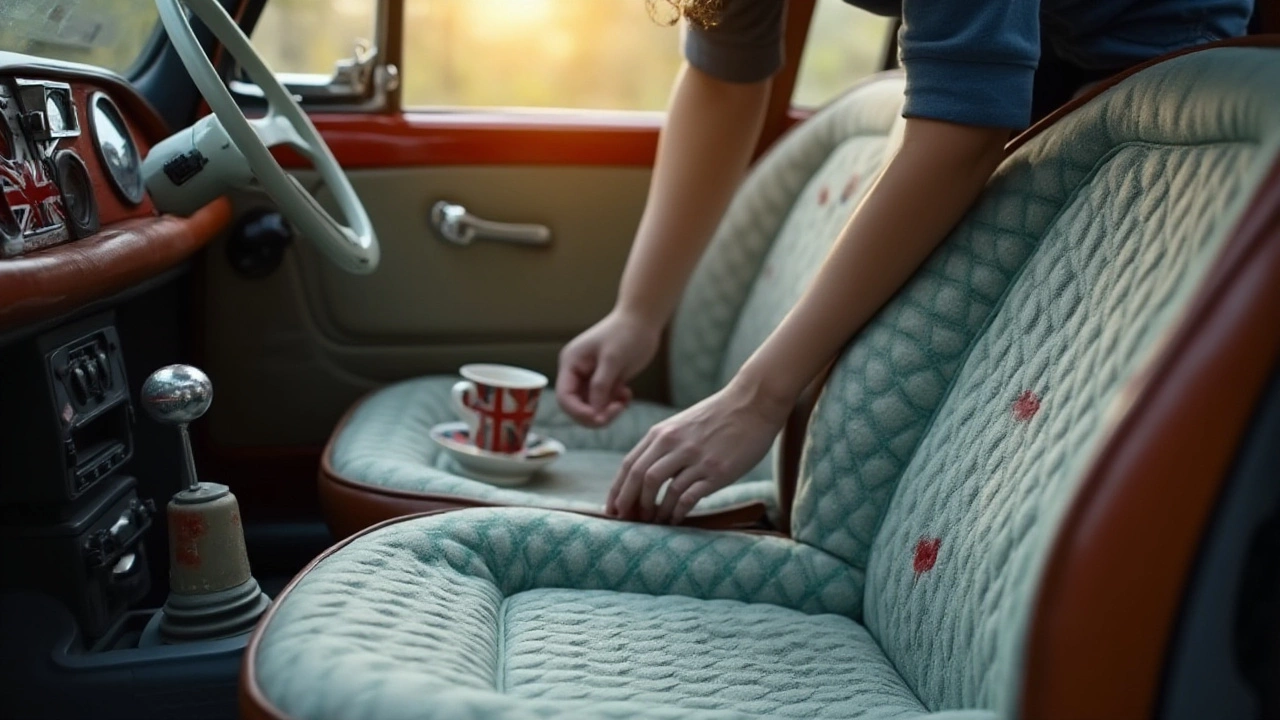
Preparing the Fabric
Before you unleash your creativity on the fabric of your car's interior, it's crucial to prepare the surface properly. Skipping this step could lead to a less durable finish and even cracking over time. Start by taking a good look at the current state of your car's upholstery. If there are stains, dust, or oil marks, it's essential to address these issues to ensure the paint adheres well. Thorough cleaning is not just a recommendation; it's a must-do to achieve a professional-looking result.
Begin by vacuuming the fabric to remove loose dirt and debris. Use a vacuum attachment with a brush to reach into seams and folds, ensuring no particle is left behind. Next, treat the surface with a fabric cleaner that's suited for your car interior material. Spray the cleaner evenly, and scrub with a soft-bristle brush. This step is crucial, as it helps to lift any ingrained dirt and oil which can prevent the paint from sticking.
Once the surface is clean, rinse off the cleaning solution thoroughly with a damp cloth, and make sure to allow the fabric to dry completely. Moisture can be disastrous when painting surfaces as it causes the paint to peel and bubble. To accelerate drying, consider using a hairdryer on a low setting or leaving the car doors open in a dry, sunny spot. Make sure the humidity is low for the best results.
At this stage, it's worth addressing any repair needs. If there are tears or worn-out sections in the fabric, patch them up meticulously before proceeding. You can get upholstery repair kits from automotive stores, which usually include swatches of repair material and adhesive. A smooth surface will garner a much more pristine finish, and extending the life of your new look is always a gain.
Some experts advocate for a light sanding of tougher fabric surfaces, like vinyl, to create a suitable texture for the paint to grip better. While this step is not universal, for some types of thicker fabrics, it enhances adhesion. If you decide to sand, do so gently with fine-grit sandpaper and ensure to clean up the residue afterward. Priming is also a consideration if you're using certain types of paint, especially if they recommend a primer to ensure the longevity of the coat.
Finally, protect areas not meant to be painted. Use painters tape to cover seams or adjoining surfaces you want to keep neat. Remember, painting a car interior is not a race, but a careful process valuing preparation over haste. As a veteran in car customization, James O’Neil once said,
"The finish is only as good as what lies beneath; preparation is your best ally in painting."
Step-by-Step Painting Process
Painting the car interior fabric involves a mix of preparation, precision, and patience. This process allows you to rejuvenate your vehicle's look without shelling out a fortune. The journey begins with thorough preparation. Start by finding a well-ventilated workspace. Good airflow not only ensures your safety but it also aids in drying times. Next, protect areas that you won't be painting with masking tape or plastic sheeting. This helps in keeping clean lines and avoids any accidental spills on surfaces you intend to leave as is.
Once you’ve sequestered your workspace, the real task begins with cleaning the fabric. The importance of this step can not be overstated—dirt or grease on the surfaces can lead to poor adhesion and an uneven finish. Use a fabric cleaner suitable for your car type followed by a damp cloth to ensure all residues are removed. Dry thoroughly, as paint won't adhere well to damp surfaces. A lint roller can be handy for a quick once-over to snag any remaining debris, ensuring a pristine surface for your artistic endeavor.
The selection of the right paint is crucial for durability and finish. Specialized fabric paints or vinyl dye, readily available in automotive stores, promise the best results. Always shake the paint well before use; consistency is key for even application. Test on a small inconspicuous area first to ensure color compatibility and that your choice meets expectations. Remember, slight changes in lighting can affect perception, so check the swatch in varying conditions.
Application involves patience and steady hands. While spray paints provide ease and even coverage, a high-quality upholstery brush is best for detailing or dealing with intricate areas. Begin with a light coat, ensuring the spray nozzle or brush doesn’t get too close to the fabric to avoid splotches. True transformation comes from layering; multiple thin coats are preferable to one thick application. Each coat should dry for the recommended time on the product label before applying the next. This minimizes the risk of tackiness and ensures long-lasting results.
As renowned auto restorer Jay Leno once noted, "The secret to a great paint job lies in the details—proper prep and patience define the outcome." This wisdom is as applicable to your car's interior as it is to any vintage car restoration project.
With your desired hue achieved, finishing with a fabric sealant can add years to the life of your paint job. These protective layers prevent fading and wear while enhancing the paint's vibrancy. Application is similar to the paint—use even strokes or sprays and ensure all surfaces are covered. Let your masterpiece cure for at least 48 hours before regular use. During this curing phase, avoid wetness or excessive handling, which could wrinkle or damage the finish.
Here's a quick reference table for paint drying times based on commonly used products, which may vary by brand and environmental conditions:
| Product | Initial Dry Time | Full Cure Time |
|---|---|---|
| Vinyl Dye Spray | 20 minutes | 24 hours |
| Fabric Paint Spray | 1 hour | 48 hours |
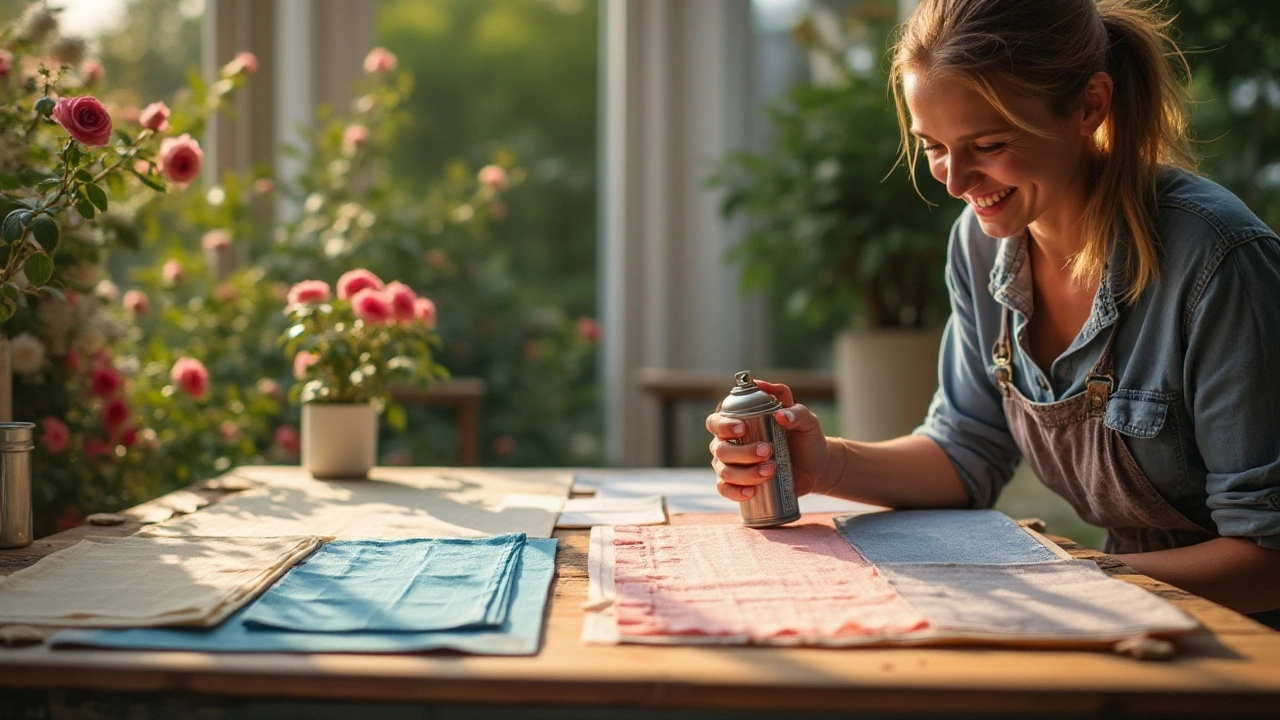
Care and Maintenance of Painted Fabric
Once you've given your car interior fabric a fresh paint job, preserving its new look is essential to ensure its longevity. A good maintenance routine begins with understanding that painted surfaces, even on fabrics, need regular attention to stay vibrant and intact. Dust and dirt are your fabric’s worst enemies; they not only dull the paint but can cause wear over time. Regular gentle vacuuming can help keep dust at bay. When vacuuming, be sure to use a soft brush attachment to avoid scratching or damaging the paint. In areas exposed to direct sunlight, consider using sunshades or parking in the shade to reduce sun damage, which can cause fading or cracking of the painted fabric.
Cleaning painted fabric requires a careful approach. Rather than using harsh chemical cleaners, opt for mild soap mixed with water. A soft cloth or sponge gently dabbed over the stained areas should suffice. Always test a small, inconspicuous area first to ensure it doesn’t damage the paint. An interesting piece of advice came from interior car styling expert Mark Jeffords, who once said,
"The gentler you are with maintaining your car’s painted interior, the longer it will last. Think of it as a piece of art that needs to be celebrated, not just a surface to wipe down."To further protect the painted fabric, consider applying a fabric sealant designed for use on painted surfaces, which acts as a protective barrier against stains and fading.
Monitoring the environmental conditions your car faces is another critical aspect for maintaining its interior. High humidity or excessive cold can sometimes be problematic if the paint isn't suited to such extreme conditions, leading to cracking or peeling. If you live in an area with such climates, invest in a good quality car cover to shield your vehicle when not in use. It’s also beneficial to avoid eating or drinking inside the car as spills can lead to stubborn stains that are challenging to remove without damaging the paint. If a spill does occur, quick action is vital—blot the area immediately rather than rubbing, as this can spread the stain.
Finally, stay vigilant for signs of wear, such as chipping or fading. Address any issues promptly before they escalate. If touch-ups become necessary, it’s best to use the same paint and techniques initially applied. This ensures consistency and longevity of the color and quality. Maintaining a painted car interior fabric is like tending a garden; regular care results in beauty and satisfaction. By investing a little time frequently, you'll keep the interior looking as stunning as the day it was painted.
Creative Ideas for Custom Designs
Painting car interior fabric opens a door to endless possibilities, allowing you to truly personalize the space you spend significant time in. Imagine turning a dull seat into a vibrant masterpiece that tells a story, captures a feeling, or simply makes you smile every time you hop in. Custom designs on car interior fabric can range from subtle shifts in shade to explosive bursts of color that redefine what car interiors can look like.
One popular way to begin this process is by selecting a theme. Themes can range from natural elements like leaves or waves to geometric patterns such as chevrons or intricate mosaics. When you have a theme in mind, the next step is sketching your ideas on paper to visualize how they will translate onto the fabric's surface. These ideas can later be refined as you get more comfortable with the process. Embrace the opportunity to make each seating area unique by employing an asymmetrical design, where each seat tells its own part of a larger narrative.
Another approach to consider is drawing inspiration from modern art movements. Abstract designs reminiscent of the bold strokes from Impressionism, or the surreal perspectives of Cubism, can dramatically change the ambiance within your car. As artist Pablo Picasso once said, "Everything you can imagine is real."
"The use of color in design is like a spell; it lures the viewer into a deeper interaction with the piece."— Bridger Zadina, Automotive DesignerBy playing with contrasting colors against the existing interior, you can create visual energies that lift the mood of the space. Ambient hues like blue or green can instill calm, while vibrant colors like red and orange can energize.
If you're looking to add a sentimental value, consider incorporating quotes or motifs that hold personal significance. Using a stencil, outline a favorite quote or symbolic design that resonates with your values or experiences and paint it onto the backrest or headrest. For a subtler touch, use a monochromatic palette, where varied shades of a single color echo across the car interior, creating harmony and depth without overwhelming visual stimulus. This approach is particularly appealing when balanced against the existing car interior features such as the dashboard and trims.
For those who love layers and texture, consider mixing different types of paint to play with dimensions. Adding light-reflective metallic paints can accentuate certain areas, giving the illusion of spaciousness or depth. You can also experiment with layering techniques, starting with a base coat and then hand-painting additional, finer details, much like a painting canvas. Be sure to use quality fabric paints designed to withstand wear, as they provide a long-lasting finish that won't easily fade or crack under daily use. DIY car projects like this empower you with control not only over the aesthetics but also over the emotions your personalized design is meant to evoke whenever you drive.

